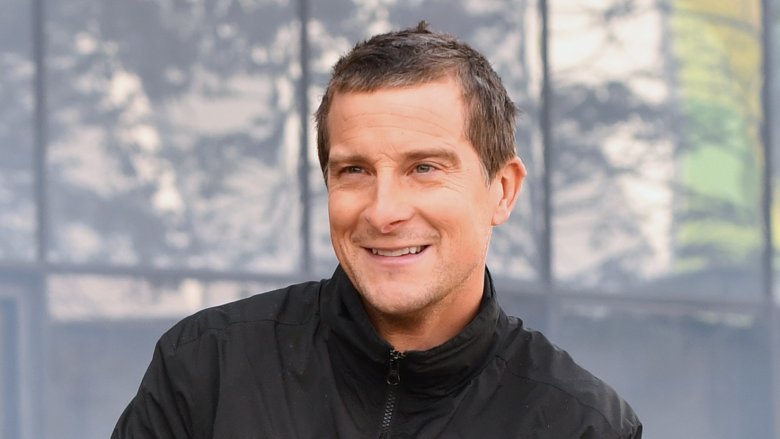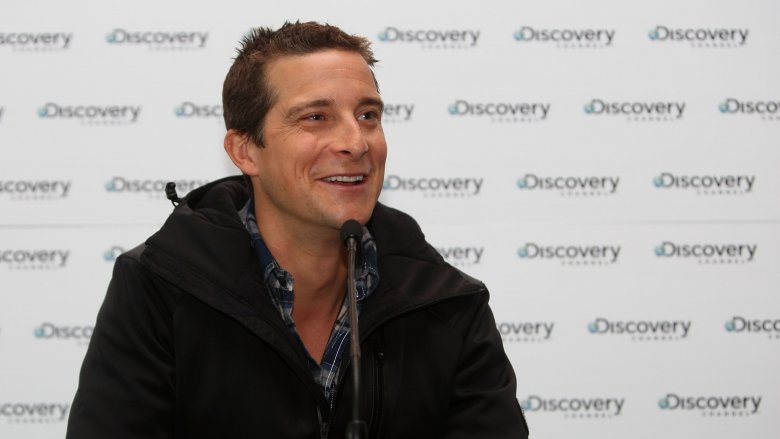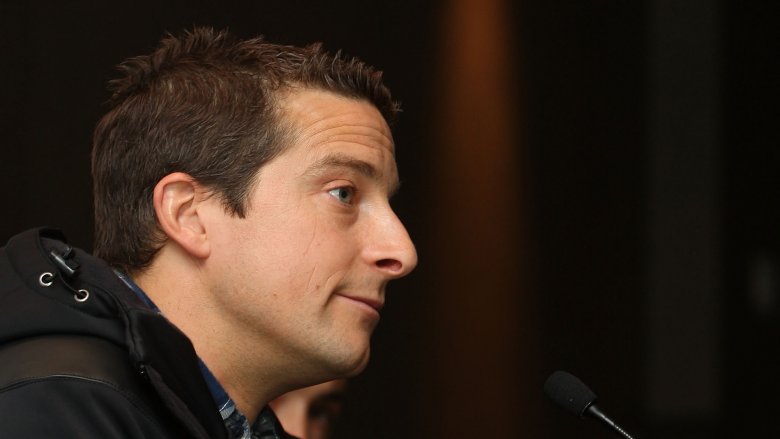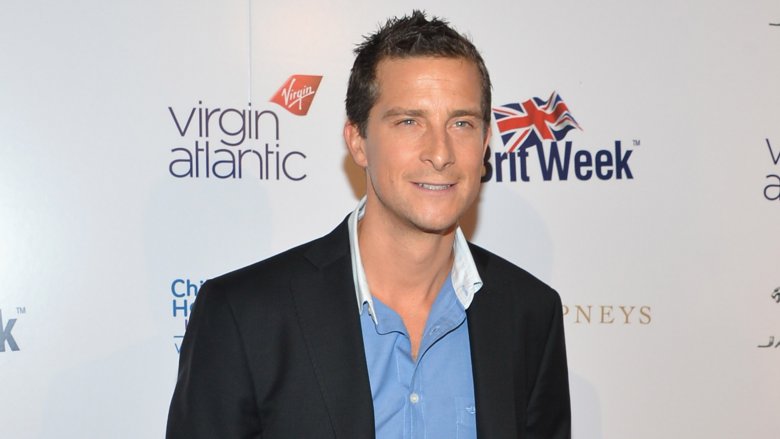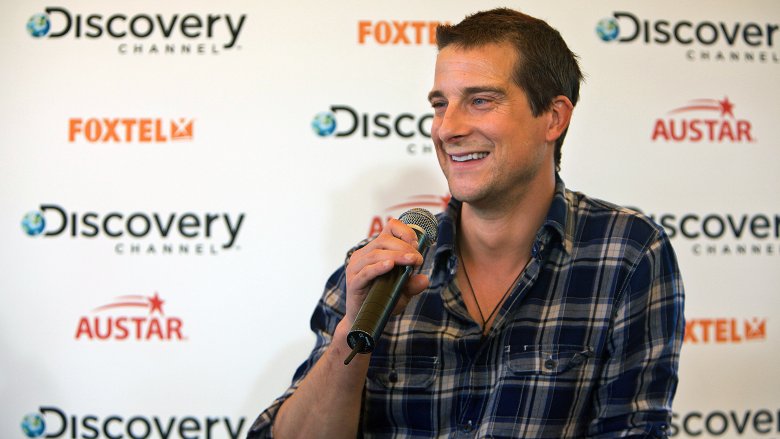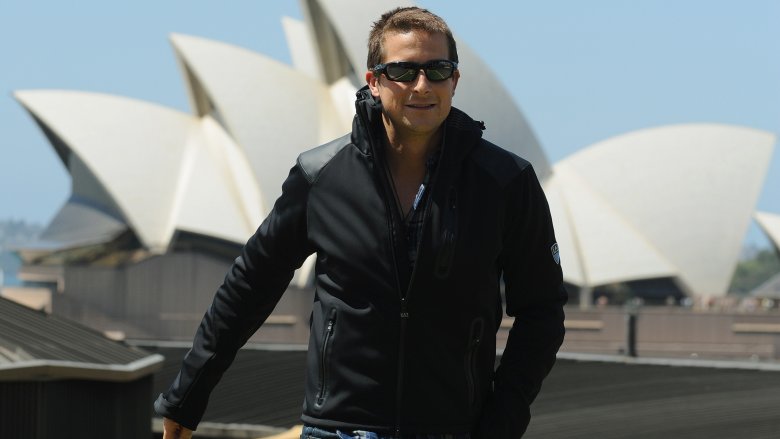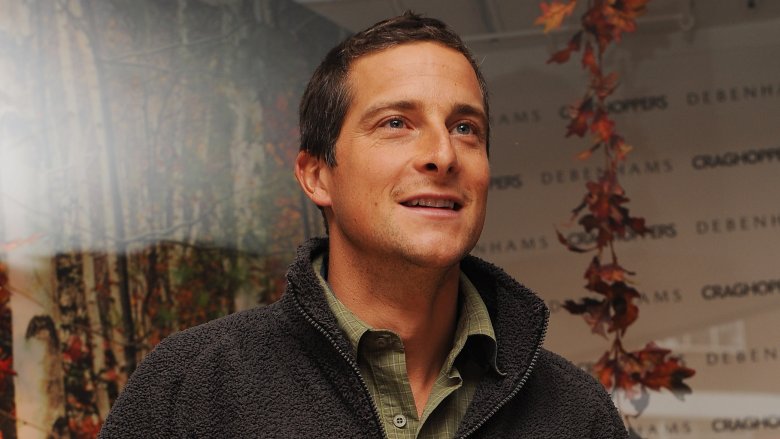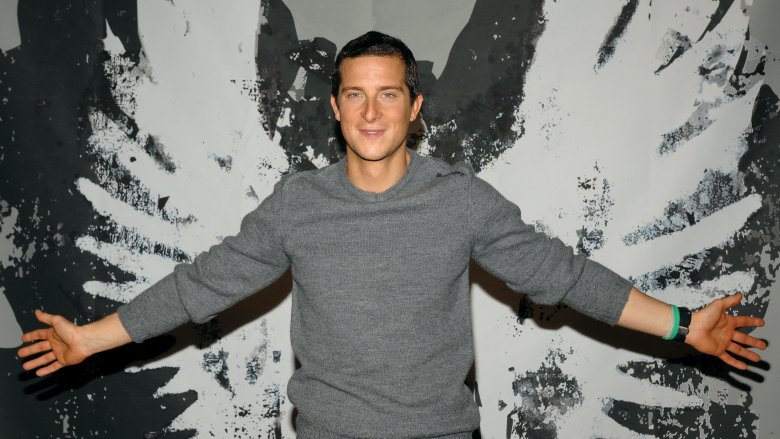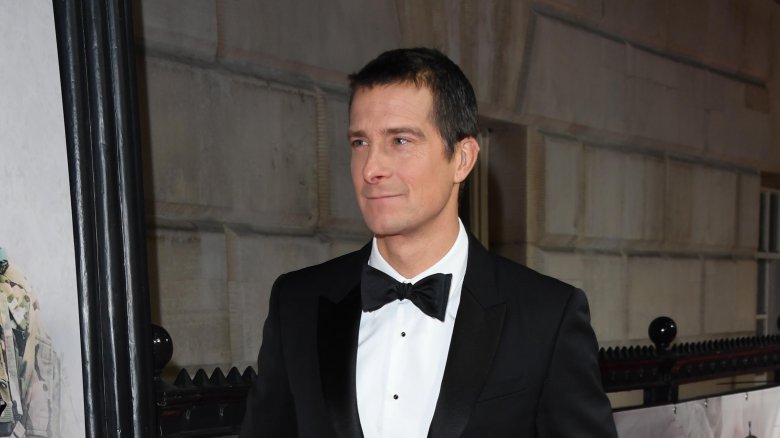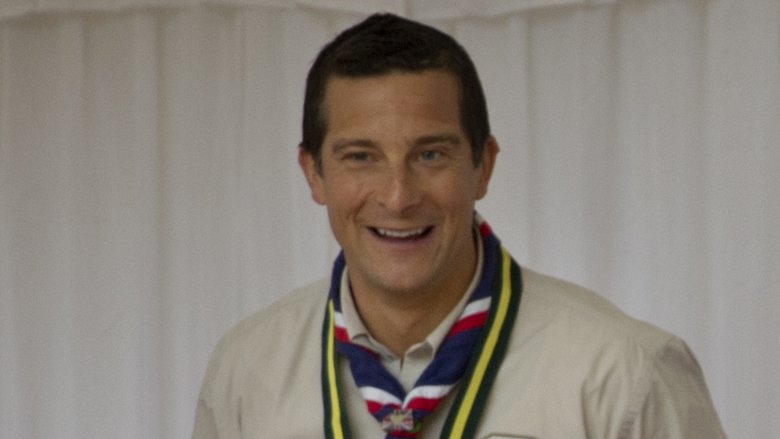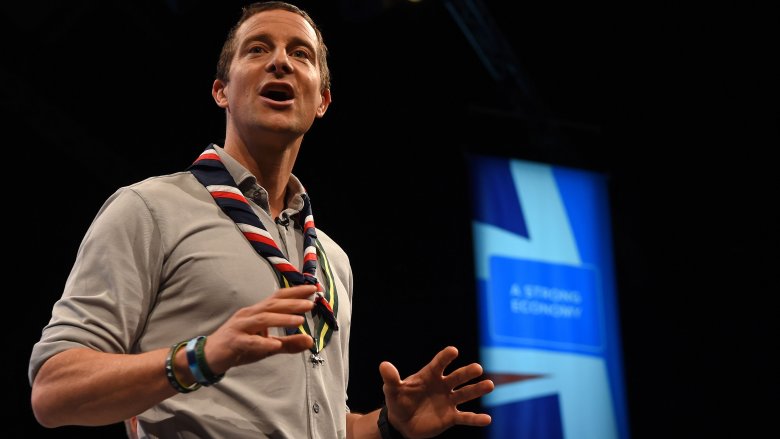Bear Grylls Stunts That Were Totally Fake
It seems like there's nothing Bear Grylls can't do. Whether he's stuck on a desert island, scaling a cliff, jumping out of a helicopter, or wading through white water rapids, there is no precarious situation he can't find his way out of. Grylls' survival expertise has earned him opportunities to host several TV shows, with his most popular, Man vs. Wild, running for seven seasons. He's also hosted similar shows like The Island and Running Wild with Bear Grylls.
Although Grylls is certainly more competent than the average person when it comes to surviving in the wilderness — after all, we're talking about a guy who has climbed Mt. Everest — fans were disappointed when the news broke that some of the events in Man vs. Wild and The Island were dramatized by the crew or downright fake. But at the end of the day, these are reality TV shows, and presenting events as authentic and unaltered while secretly scripting and staging important scenes is common. Here are a few events that Grylls didn't really have to "survive" — but it sure made for a better story onscreen.
"Borrowing" tame horses
After one infamous episode in the first season of Man vs. Wild, in which Grylls had to survive in the Sierra Nevada mountain region, several claims that the show was staged tarnished Grylls' reputation.
This area is home to some of the last truly wild horses in the United States, and wild mustangs have lived in this area for centuries. In this episode, Grylls was shown attempting to lasso some of the steeds, but it turned out that these mustangs might not have been so wild after all — the crew reportedly "hired" them from a trekking station near their filming location. These were actually relatively tame animals that were accustomed to being around humans. Of course, that doesn't play as well to audiences. What makes for a more interesting scene: showing Grylls trying to sling a lasso around a "wild" mustang, or admitting that the crew essentially rented a few horses that weren't actually running wild? The answer is obvious.
Spending the night at a resort
In the same episode show in the Sierra Nevada, Grylls came under fire for hiding some other important details from his audience. He stated that he was roughing it as always — however, he may have been stretching the truth a bit. During the day, he was out in nature, but he actually spent a few nights at a cozy resort, which is a far cry from huddling in a hastily built shelter and hiding from the elements.
When the cameras stopped rolling, Grylls was holed up at the Pines Resort at Bass Lake, a luxury hotel for tourists in the area. Grylls has insisted that it wasn't as deceptive as it seemed — in fact, he basically implied that it was necessary for him to rest up on his journeys in order for him to perform at his best on the show. "I spend a lot of nights under the stars," Grylls told Outside Magazine, "and for the times when I am not filming the live stuff out in the wild, or I'm about to illustrate something really physically exhausting, I stay with the crew in a base-camp lodge."
His crew member dressed up as a bear
What could be more terrifying than camping in the middle of the woods and hearing a large animal brushing up against your tent? If you're in bear country, an experience like this is bound to send a shiver up your spine. Supposedly, this happened to Grylls one night while shooting an episode in the Rocky Mountains. However, word got out that the scene was scripted in advance, and the threatening "bear" lurking outside the tent was reportedly a crew member in a bear costume. Suddenly, that scene doesn't seem so scary after all.
Discovery Channel insisted that the scene was intended to be a prank, but it certainly wasn't presented that way in the final cut of the episode. Initially, producers hoped to "hire" a trained bear, but when they were unable to do so, the crew decided to completely fake the scene rather than scrapping the idea altogether.
Using smoke machines
Everyone knows that an active volcano poses a threat because of a lava flow, but there are other dangers that can be present, like toxic gas. In an episode of Born Survivor in which Grylls explores the Mount Kilauea volcano in Hawaii, he's shown working to avoid patches of molten lava and clouds of so-called "killer" gas.
Grylls said the visible gas in this scene was sulphur dioxide, which is deadly at higher concentrations. There's only one problem with this claim: sulphur dioxide is actually invisible. Yes, it is toxic when inhaled, but Grylls wasn't actually in danger of breathing in these fumes. Where was the "sulphur dioxide" coming from? It was reportedly created by smoke generators that the crew was operating off-camera. And as for the lava itself? The crew used burning coals to boost the drama factor. An active volcano is scary enough — they probably didn't have to add all that.
His team puts together materials for him
In Man vs. Wild, Grylls was supposed to be on his own in whatever inhospitable environment he ended up in. After all, it's called Man vs. Wild, not "Grylls and his crew lending a helping hand vs. Wild." But it's been revealed that Grylls has been assisted by his crew on several occasions without letting the audience in on the truth — even when he was not in immediate danger.
After serving as a consultant on the show, survival expert Mark Weinert warned viewers, "If you really believe everything happens the way it is shown on TV, you are being a little bit naive." For instance, in one episode that Weinert worked on, Grylls supposedly built a raft using only natural materials that he found around him, like hibiscus twine, palm leaves, and bamboo. However, Weinert said that he personally worked with a team of builders to put the raft together; then it was taken apart so Grylls could be filmed putting it together on camera.
Sleeping in a motel
The expose of the Sierra Nevada episode wasn't the only time Grylls was accused of staying in a hotel when he claimed he was spending the night at the mercy of the elements. During an episode shot in Hawaii, Grylls referred to himself as a "real life Robinson Crusoe" who had been stranded on a desert island and had to hack it on his own, but according to reports, he wasn't sleeping on the beach or in the jungle — he was actually sleeping in a motel.
Look, staying in a hotel room in Hawaii sounds more like a vacation than an epic quest to survive in the wild. Of course, Grylls would probably explain it away just as he did when fans were upset with him for secretly staying at the Pines Resort. Clearly, this was a pattern behind the scenes, and while audiences pictured Grylls struggling to fall asleep in the wilderness most nights, he actually may have been safe in a hotel bed.
Covering up credentials
Grylls is best known for hosting Man vs. Wild, but he also hosted another show called The Island, which featured 13 men who had to fend for themselves on a desert island. They were described as "ordinary men" who had no choice but to see what they were really made of. In fact, at one point the audience was told, word for word, that "none of these man had any experience living in the wild." However, this statement later turned out to be blatantly false.
In fact, four of the men did have extensive outdoor survival experience, and two of them had even worked with Grylls before. The network defended the show by pointing out that a voiceover explained that there were some trained professionals in the group. At best, this was just a case of the show's premise being poorly explained, but at worst, the producers wanted to draw people in by misleadingly advertising it as a show about total amateurs surviving in the wild.
The crew provided essentials on The Island
Grylls' show The Island was also called out for a few other false claims. The men on the show were supposed to be surviving on their own without any assistance, but the guys actually got help with one of the most crucial aspects of wilderness survival: a reliable water source. The producers eventually came clean and stated that a pool of water on the island was lined with rubber so that it wouldn't dry up, since the men would be staying there through the dry season and the producers had to ensure that they would have a consistent water supply.
Naturally, leaving the cast truly stranded without water would be way too risky, but perhaps the most transparent thing the producers could have done would be to explain that the cast could be assisted with certain challenges to avoid serious harm. That's fair enough, but it's not the same as truly surviving in the wild.
Releasing crocodiles on a desert island
There was one other instance of fakery associated with The Island. The producers stated that they needed to be certain that there would be "enough native animals and native vegetation that could sustain the men for 28 days — as long as they had the ingenuity to find it, catch it, and kill it." To make sure of this, they released two caimans on the island.
This species of crocodile is indigenous to the island, so it's not like they were introducing an invasive species to this ecosystem just for the sake of the show. And it's understandable that they wouldn't want any of the men to go hungry just for the sake of authenticity. But no matter how you slice it, it's still not the equivalent of surviving when you're actually stranded in the wild. Sure, no one should be running off to try tactics that they have only seen on the show, but it's still misleading and makes it look easier than the reality.
Getting help from survival experts
In addition to Mark Weinert, Grylls and his crew often brought on other survival experts as consultants on Man vs. Wild. There was nothing shady about that in particular, as long as they weren't doing Grylls' work for him. But on at least one occasion, a consultant later revealed that this was exactly what was going on.
Nick Vroomans, who has worked as the director of Staying Alive Survival Services, also worked with Grylls on an episode of Man vs. Wild in western Australia. Vroomans said that while he enjoyed his experience working on the show and thought that Grylls was a good person overall, viewers should know that the show was predominantly scripted ahead of time. Vroomans also explained that he was often responsible for building Grylls' shelters and finding him animals to eat — in this episode, it was specifically snakes. Admitting he was disappointed by the final cut of the episode, Vroomans added, "Whatever he does isn't survival, but it's definitely entertaining."
Using wind machines
After seeing Grylls get into so many tricky situations over the years, it's only natural to wonder when he felt the most afraid. Grylls actually cried on camera for the first time in an episode in the sixth season of Man vs. Wild because of an intense weather event that left him shaken. But the funny thing is that his crew basically manufactured the entire situation.
Grylls wanted to create storm conditions in Norway, and the crew decided to use huge wind machines in order to make everything more dramatic. But this made it very difficult for Grylls to build a shelter and start a fire. Grylls knew he'd be safe in the end, but he said the fear still stuck with him. Of course, Grylls could have easily avoided this situation by keeping things real, but that might not have made for a good scene, so they decided to raise the stakes.
Misrepresenting survival techniques
Les Stroud, also known as Survivorman, is another big name in the outdoor survival community. He was also the host of the show Survivorman, which had a similar premise to Man vs. Wild – but Stroud insists that his show was a much more realistic picture of what it's like to survive in the wild, and Man vs. Wild was basically a sham.
Stroud is not a big fan of Grylls, and he made this very clear in a Reddit AMA several years ago. He stated that many of the survival skills that Grylls had "taught" on the show would actually not be very helpful. For example, Stroud singled out an episode in which Grylls was shown squeezing drinking water from elephant dung, something Stroud claims would be impossible unless the crew specifically soaked it with water beforehand. Moral of the story? Man vs. Wild shouldn't be seen as a realistic, documentary-style show — it's entertainment above anything else.


